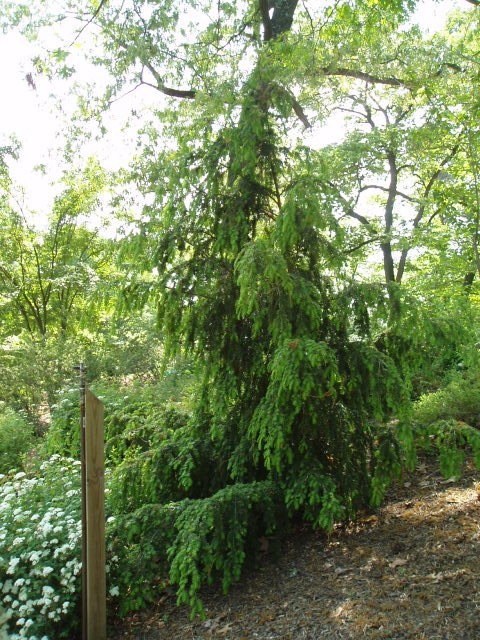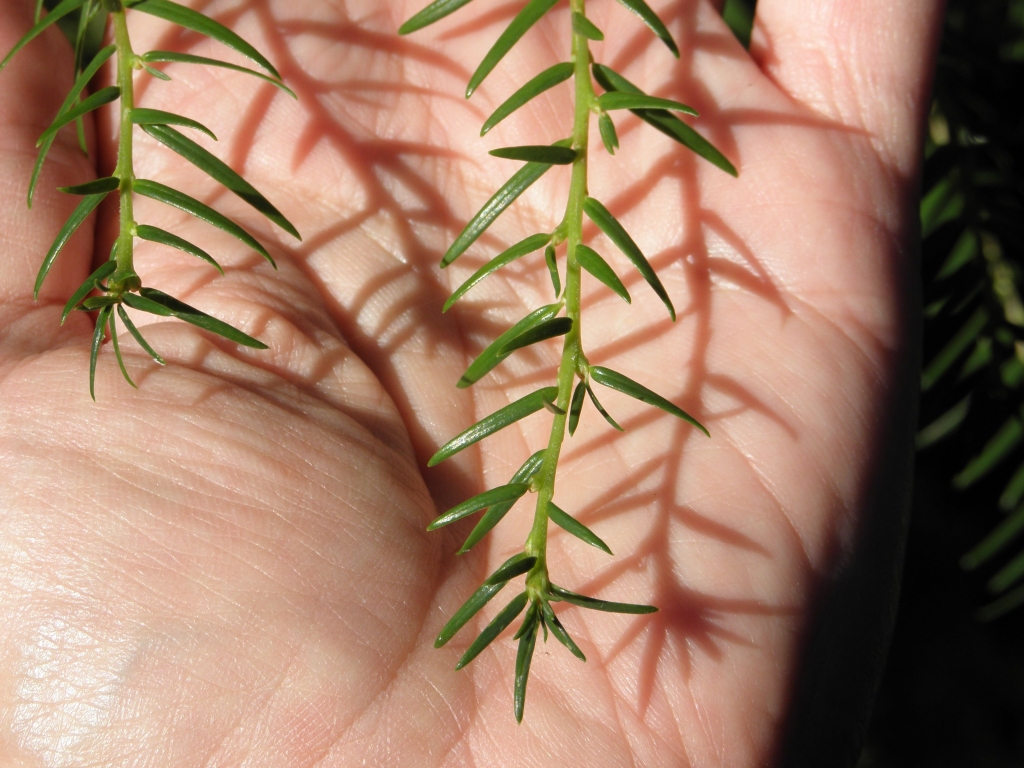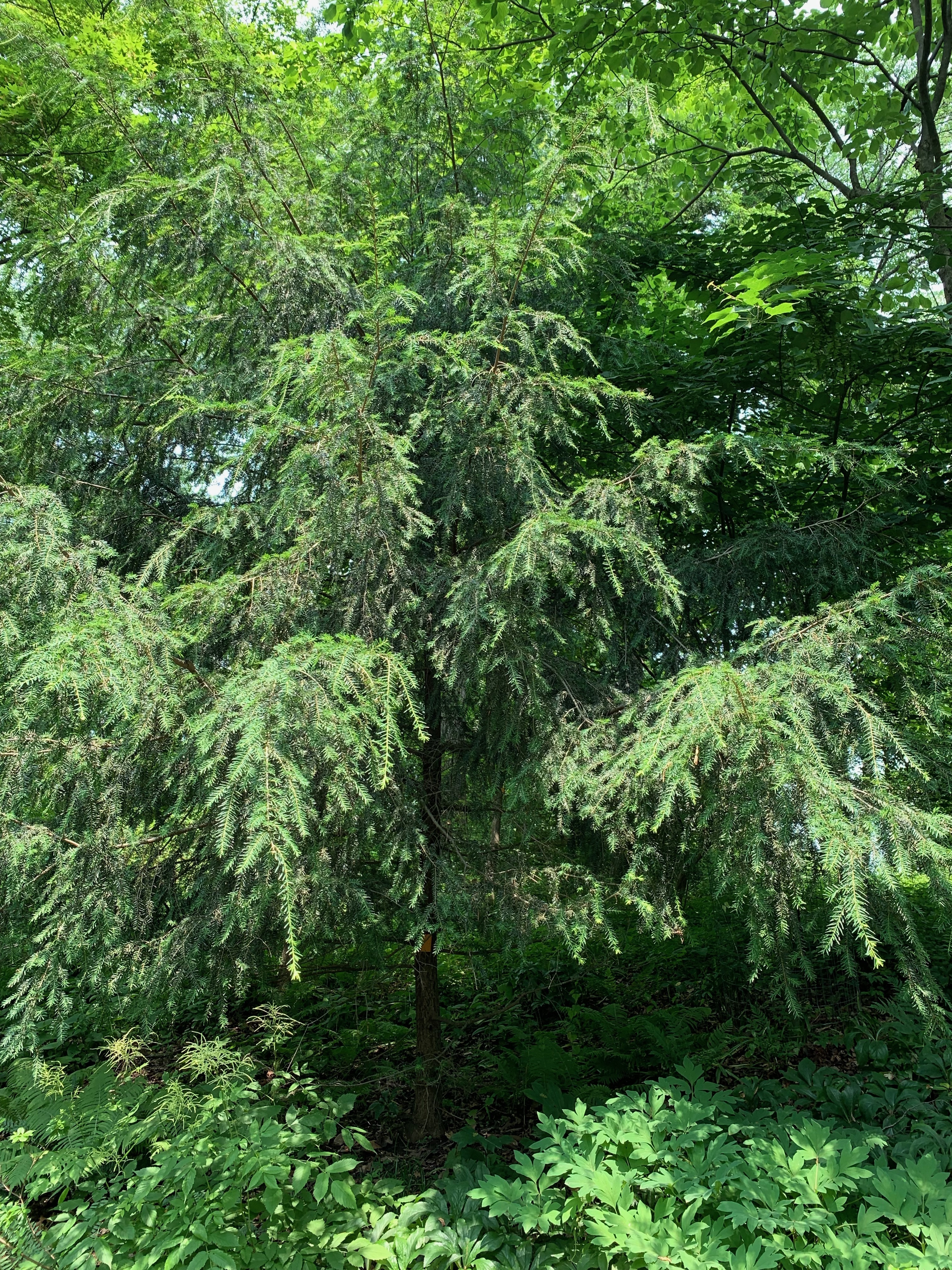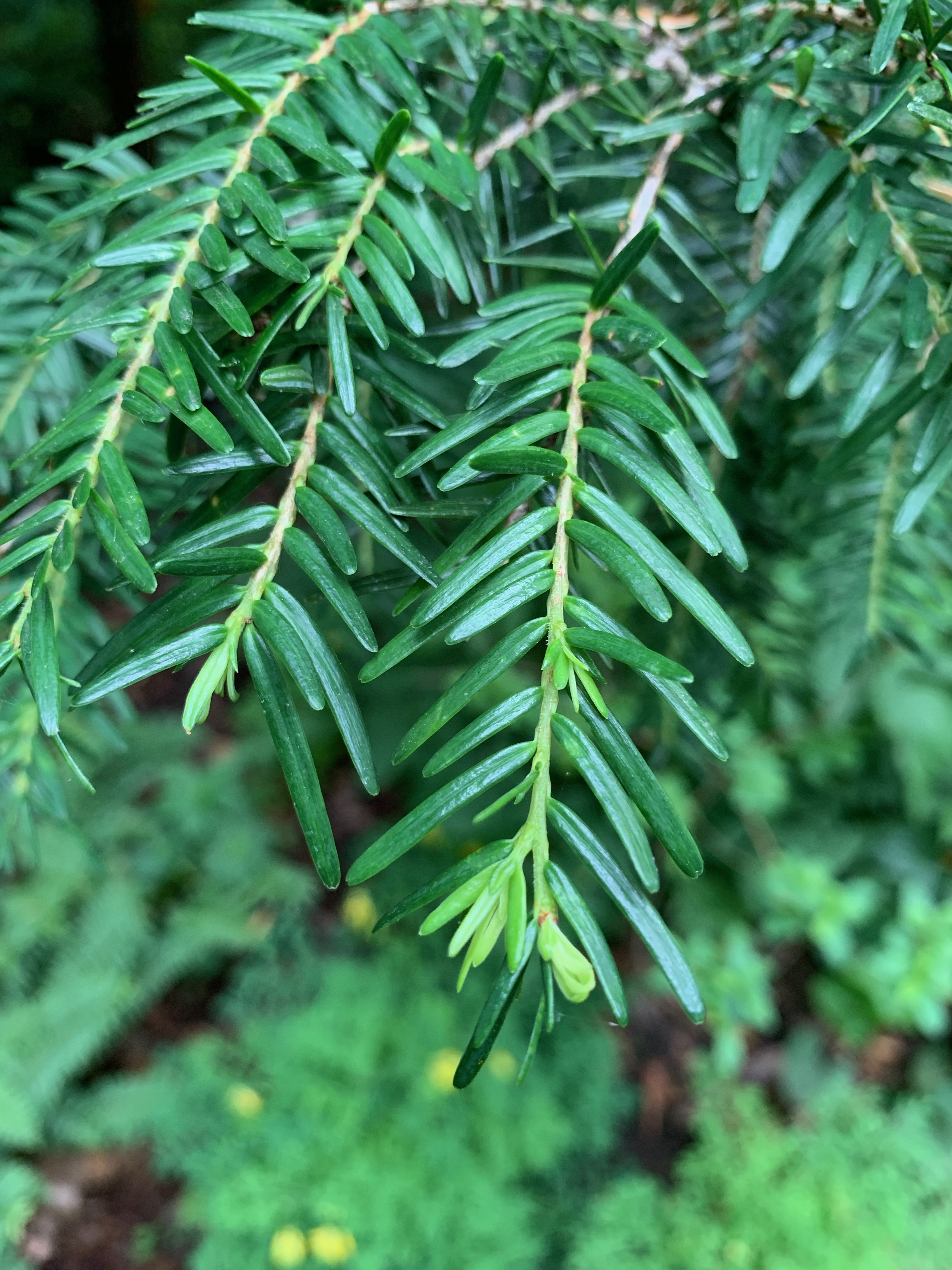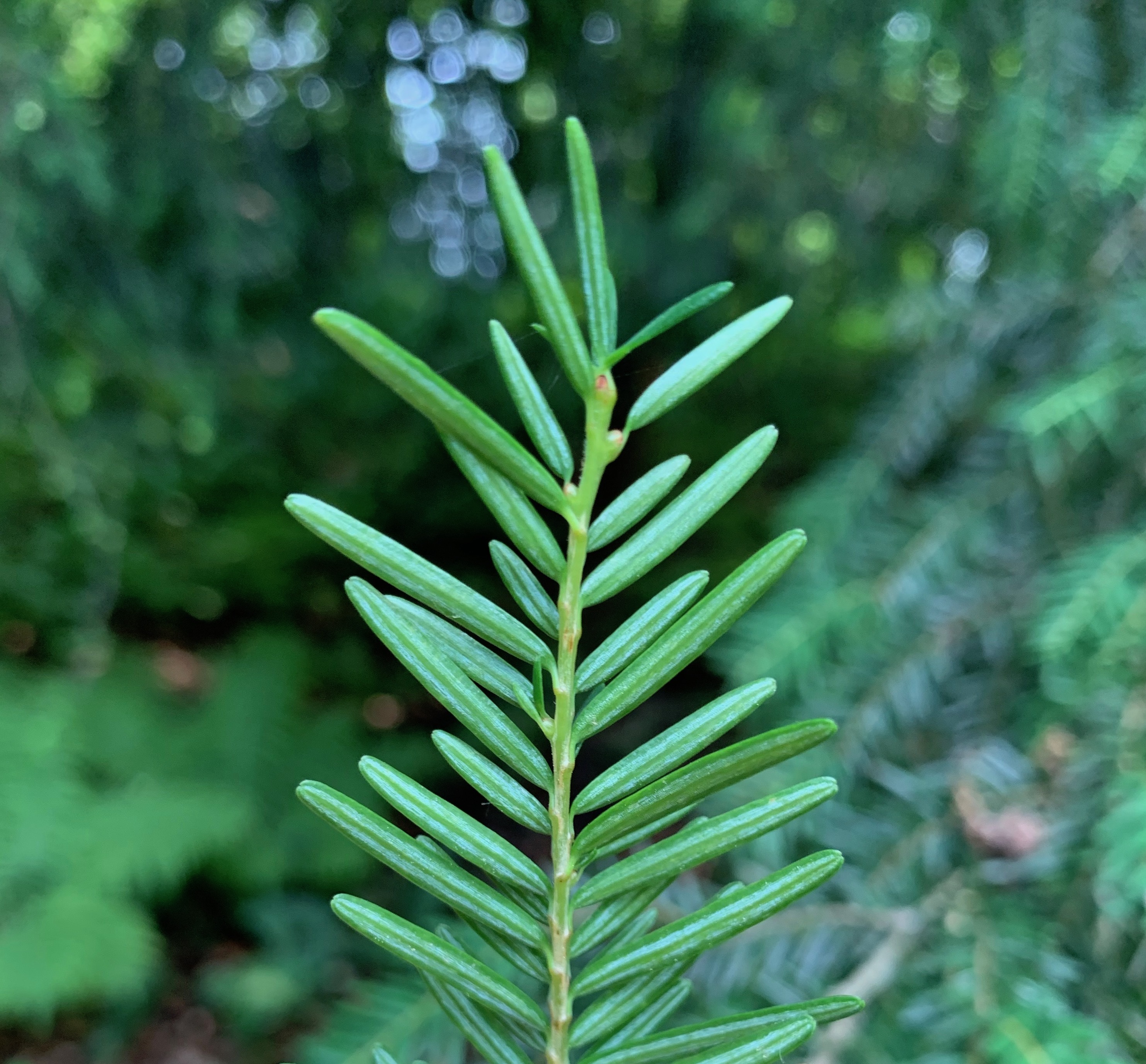Tsuga chinensis, first described in 1900 by (Franchet) Pritzel ex Friedrich Ludwig Emil Diels (1874-1945), is commonly known as Taiwan or Chinese hemlock, or in Chinese as é“æ‰ (TiÄ›shÄn), literally: "iron fir" in the Chinese language.
There are a number of varieties of T. chinensis, though there is much dispute over which are valid and whether some constitute distinct species or not. All in all there are six varieties, though not all are accepted universally. These are:
- T. c. var. chinensis is the type variety and occurs across most of the range in mainland China and Tibet. Its seed scales are pentagonal-ovate, subsquare, or suborbicular, while its branchlets are 0.04 inch (1 mm) in diameter and gray to yellow-gray in color. The seed cones are ovoid and 0.6 to 1 inch (1.5 - 2.5 cm) long by 0.48 to 0.6 inch (1.2 - 1.6 cm) wide.
- T. c. var. formosana is the variety that occurs exclusively in Taiwan. Aljos Farjon, a conifer expert from the Royal Botanic Gardens at Kew, considers this variety identical with the type, but according to Raven and Wu it differs from the type by having seed scales which are compressed orbicular to nearly semiorbicular. Otherwise, however, it is like the type.
- T. c. var. forrestii is treated as a separate species, namely Tsuga forrestii, by some authorities. The cones are larger, more slender and narrow-ovoid to ovoid-cylindric. The branchlets are slightly thicker, while the seed scales are narrowly ovate or oblong with the exposed part striate and glabrous with a thickened margin. Regardless of its taxonomic status, it is considered threatened by the IUCN. It occurs only in northeast Guizhou, southwest Sichuan and northwest Yunnan.
- T. c. var. oblongisquamata is considered a separate species by Raven and Wu, namely T. oblongisquamata, but as a variety by Farjon. It occurs in the northern part of the range, namely in southern Gansu, western Hubei and northwest Sichuan. It differs most sharply in lacking visible stomatic bands beneath the leaves. Otherwise the seed scales are more loosely arranged and loosely elliptic in shape, being nearly twice as long as they are wide.
- T. c. var. patens is found only in western Hubei province on Changyang Xian. It differs in having brownish yellow to brown branchlets, which are between to 0.02 to 0.04 inch (0.5 - 1 mm), greater in diameter than the type. The seed cones also differ in being slightly larger, ovoid-globose in shape, and with seed scales that are smooth, shiny and almost square. This variety is recognized by Raven and Wu.
- T. c. var. robusta is probably the most universally recognized of the varieties. It is present in western Hubei and western Sichuan provinces. It again exhibits the thicker branchlets and larger cones, but the cones are stout and shortly cylindric. Also, the seed scales are square-orbicular with the exposed part being pubescent and the margin not thickened. In addition, the bracts are cuspidate at the apex.
Description. Taiwan hemlock is a large evergreen coniferous species of tree which will grow to mature heights of 150 feet (50 m) tall with trunk up to 5 feet (1.5 m) wide at breast height.
- The scaly bark is blackish brown in color with irregular longitudinal breaks, and lenticels that are very inconspicuous. The outer layer is about 0.24 inch (6 mm) thick with alternating tiered layers of pale yellowish brown corky tissue, and brown lignified fibrous tissue. The newly formed periderm will be purplish red. The inner bark is about 0.16 to 0.2 inch (4 - 5 mm) thick and pale reddish brown in color. It is fibrous in texture with minute, almost inconspicuous sclereid, or stone cell groups. The cambium as well as the newly formed phloem are nearly inconspicuous. Freshly cut wood is a pale yellowish white with inconspicuous wood rays.
- The branchlets have leaf-cushions.
- Leaves are arranged spirally in a manner more or less 2-ranked. They are linear and flat in shape and olive green in color. The upper side of the leaf is grooved and keeled, while the underside has 2 white stomatal bands. The apex of the leaves are emerginate and they measure 0.6 to 0.8 inch (16 - 20 mm) long. The petioles are crooked. The foliage is very similar to that of T. heterophylla, but T. chinensis has nodding shoots and the stomatal bands are paler and more sparse. Also the color above is a paler yellowish-green.
- Pollen cones appear singly on one-year old shoots, or in groups of 1 to 5 on two-year old shoots. They are a dull purple in color and measure about 0.32 inch (8 mm) long.
- Seed cones are terminal on a very short shoot. They nod, are rosy-purple and about 0.24 inch (6 mm) in length. The mature cones are green, later turning to red-brown, long-ovoid in shape and measure 0.8 to 1 inch (2 - 2.5 cm) long by about 0.4 inch (1 cm) wide. They are pendulous and the cone scales are large and suborbicular with longitudinal streaks. The bracts are small and 2 lobed at the apex. The seeds are winged and measure about 0.28 inch (7 mm) long including the wing.
Distribution. The range of T. chinensis begins in the west in Tibet and continues east into China, north to southern Shanxi province and south to Taiwan, Guangdong province and the north of Ha Giang province in northern Vietnam. In the very south of its range they are only found high in the mountains. For example in Vietnam the tree is only found in mountains at elevations of 4,000 to 5,500 feet (1,300 - 1,700 m) above sea level. In China it is present at elevations of 3,200 to 10,000 feet (1,000 to 3,500 m) in the following provinces: Anhui, Fujian, southern Gansu, Guangdong, Guangxi, northern Guizhou, western Henan, western Hubei, Hunan, Jiangxi, southern Shaanxi, Sichuan, Xizang, Yunnan, and Zhejiang. This comprises the southern half of the country with a few populations farther north. It is found primarily in mixed forests near river basins and in mountains and valleys. In Taiwan it is found mainly in Nantou and Taoyuan counties at elevations of 5,500 to 10,000 feet (1,700 to 3,500 m) above sea level in mixed broadleaf forests. It can be found in Taiwans's Yushan National Park and Lalashan Preserve, as well as in China's Hailuogou Glacier Park in Sichuan province.
